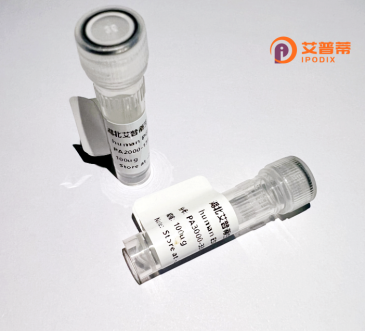
| 纯度 | >90%SDS-PAGE. |
| 种属 | Human |
| 靶点 | CYP2R1 |
| Uniprot No | Q6VVX0 |
| 内毒素 | < 0.01EU/μg |
| 表达宿主 | E.coli |
| 表达区间 | 1-501aa |
| 氨基酸序列 | MWKLWRAEEGAAALGGALFLLLFALGVRQLLKQRRPMGFPPGPPGLPFIGNIYSLAASSELPHVYMRKQSQVYGEIFSLDLGGISTVVLNGYDVVKECLVHQSEIFADRPCLPLFMKMTKMGGLLNSRYGRGWVDHRRLAVNSFRYFGYGQKSFESKILEETKFFNDAIETYKGRPFDFKQLITNAVSNITNLIIFGERFTYEDTDFQHMIELFSENVELAASASVFLYNAFPWIGILPFGKHQQLFRNAAVVYDFLSRLIEKASVNRKPQLPQHFVDAYLDEMDQGKNDPSSTFSKENLIFSVGELIIAGTETTTNVLRWAILFMALYPNIQGQVQKEIDLIMGPNGKPSWDDKCKMPYTEAVLHEVLRFCNIVPLGIFHATSEDAVVRGYSIPKGTTVITNLYSVHFDEKYWRDPEVFHPERFLDSSGYFAKKEALVPFSLGRRHCLGEHLARMEMFLFFTALLQRFHLHFPHELVPDLKPRLGMTLQPQPYLICAERR |
| 分子量 | 83.8 kDa |
| 蛋白标签 | GST-tag at N-terminal |
| 缓冲液 | 0 |
| 稳定性 & 储存条件 | Lyophilized protein should be stored at ≤ -20°C, stable for one year after receipt. Reconstituted protein solution can be stored at 2-8°C for 2-7 days. Aliquots of reconstituted samples are stable at ≤ -20°C for 3 months. |
| 复溶 | Always centrifuge tubes before opening.Do not mix by vortex or pipetting. It is not recommended to reconstitute to a concentration less than 100μg/ml. Dissolve the lyophilized protein in distilled water. Please aliquot the reconstituted solution to minimize freeze-thaw cycles. |
1. **"CYP2R1 is a major, non-redundant contributor to 25-hydroxyvitamin D production in vivo"**
*作者: Cheng JB et al.*
摘要:研究通过重组人CYP2R1蛋白在小鼠模型中的表达,证实其在维生素D 25-羟化中的关键作用,揭示其不可替代的催化活性及其与维生素D代谢疾病的关联。
2. **"Structural basis of human CYP2R1-mediated vitamin D hydroxylation"**
*作者: Strushkevich N et al.*
摘要:利用X射线晶体学解析重组人CYP2R1的蛋白结构,阐明其底物结合口袋和催化机制,为维生素D代谢异常相关突变的分子机制提供依据。
3. **"Functional characterization of CYP2R1 mutations in vitamin D-dependent rickets"**
*作者: Casella A et al.*
摘要:通过体外重组表达突变型CYP2R1蛋白,分析其酶活缺陷,发现某些突变导致25-羟化功能丧失,直接关联遗传性佝偻病的发病机制。
4. **"Recombinant expression and kinetic analysis of human CYP2R1 in insect cells"**
*作者: Hacker SM et al.*
摘要:优化重组人CYP2R1在昆虫细胞中的表达与纯化流程,测定其催化维生素D的动力学参数(Km/Vmax),为药物代谢及毒性研究提供工具基础。
以上文献涵盖CYP2R1的功能验证、结构解析、病理突变机制及重组表达技术,均为该领域经典研究。
Recombinant human CYP2R1 is a genetically engineered form of the cytochrome P450 2R1 enzyme, a critical player in vitamin D metabolism. As a member of the CYP superfamily, CYP2R1 is predominantly expressed in the liver and functions as a 25-hydroxylase, converting vitamin D3 (cholecalciferol) into 25-hydroxyvitamin D3 [25(OH)D3], the major circulating form of vitamin D. This enzymatic step is essential for maintaining calcium homeostasis, bone health, and immune modulation. Deficiencies or mutations in CYP2R1 are linked to vitamin D-dependent rickets and autoimmune disorders, underscoring its physiological importance.
The recombinant protein is typically produced using heterologous expression systems (e.g., E. coli, insect, or mammalian cells) for biochemical and structural studies. Its production enables detailed investigation of catalytic mechanisms, substrate specificity, and interactions with vitamin D analogs or inhibitors. Recent structural analyses reveal CYP2R1's conserved α-helical and β-sheet folds, along with a heme-binding domain critical for hydroxylation activity. Researchers also explore its potential as a therapeutic target for diseases involving vitamin D dysregulation, such as chronic kidney disease or liver dysfunction. Advances in recombinant technology continue to refine its stability and activity, supporting drug discovery and personalized medicine applications.
×